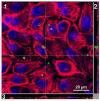Allergen particle binding by human primary bronchial epithelial cells is modulated by surfactant protein D
- PMID: 20569420
- PMCID: PMC2898774
- DOI: 10.1186/1465-9921-11-83
Allergen particle binding by human primary bronchial epithelial cells is modulated by surfactant protein D
Abstract
Background: Allergen-containing subpollen particles (SPP) are released from whole plant pollen upon contact with water or even high humidity. Because of their size SPP can preferentially reach the lower airways where they come into contact with surfactant protein (SP)-D. Our previous work demonstrated that SP-D increases the uptake of SPP by alveolar macrophages. In the present study, we investigated the uptake of SPP in human primary epithelial cells and the potential modulation by SP-D. The patho-physiological consequence was evaluated by measurement of pro-inflammatory mediators.
Methods: SPP were isolated from timothy grass and subsequently fluorescently labelled. Human primary bronchial epithelial cells were incubated with SPP or polystyrene particles (PP) in the presence and absence of surfactant protein D. In addition, different sizes and surface charges of the PP were studied. Particle uptake was evaluated by flow cytometry and confocal microscopy. Soluble mediators were measured by enzyme linked immunosorbent assay or bead array.
Results: SPP were taken up by primary epithelial cells in a dose dependent manner. This uptake was coincided with secretion of Interleukin (IL)-8. SP-D increased the fraction of bronchial epithelial cells that bound SPP but not the fraction of cells that internalized SPP. SPP-induced secretion of IL-8 was further increased by SP-D. PP were bound and internalized by epithelial cells but this was not modulated by SP-D.
Conclusions: Epithelial cells bind and internalize SPP and PP which leads to increased IL-8 secretion. SP-D promotes attachment of SPP to epithelial cells and may thus be involved in the inflammatory response to inhaled allergen.
Figures








Similar articles
-
Surfactant Protein D modulates allergen particle uptake and inflammatory response in a human epithelial airway model.Respir Res. 2012 Feb 1;13(1):8. doi: 10.1186/1465-9921-13-8. Respir Res. 2012. PMID: 22296755 Free PMC article.
-
Surfactant proteins, SP-A and SP-D, in respiratory fungal infections: their role in the inflammatory response.Respir Res. 2016 Jun 1;17(1):66. doi: 10.1186/s12931-016-0385-9. Respir Res. 2016. PMID: 27250970 Free PMC article. Review.
-
Surfactant protein D increases phagocytosis and aggregation of pollen-allergen starch granules.Am J Physiol Lung Cell Mol Physiol. 2005 Apr;288(4):L692-8. doi: 10.1152/ajplung.00362.2004. Epub 2004 Dec 10. Am J Physiol Lung Cell Mol Physiol. 2005. PMID: 15591410
-
Surfactant protein D modulates pulmonary clearance of pollen starch granules.Exp Lung Res. 2010 Nov;36(9):522-30. doi: 10.3109/01902141003790148. Exp Lung Res. 2010. PMID: 20815657
-
Biochemical composition of Phleum pratense pollen grains: A review.Mol Immunol. 2021 Aug;136:98-109. doi: 10.1016/j.molimm.2021.05.014. Epub 2021 Jun 4. Mol Immunol. 2021. PMID: 34098345 Review.
Cited by
-
Surfactant Protein D in Respiratory and Non-Respiratory Diseases.Front Med (Lausanne). 2018 Feb 8;5:18. doi: 10.3389/fmed.2018.00018. eCollection 2018. Front Med (Lausanne). 2018. PMID: 29473039 Free PMC article. Review.
-
Allergy as an epithelial barrier disease.Clin Transl Allergy. 2011 Jun 10;1(1):5. doi: 10.1186/2045-7022-1-5. Clin Transl Allergy. 2011. PMID: 22410284 Free PMC article.
-
Surfactant Protein D modulates allergen particle uptake and inflammatory response in a human epithelial airway model.Respir Res. 2012 Feb 1;13(1):8. doi: 10.1186/1465-9921-13-8. Respir Res. 2012. PMID: 22296755 Free PMC article.
-
In silico study reveals binding potential of rotenone at multiple sites of pulmonary surfactant proteins: A matter of concern.Curr Res Toxicol. 2021 Dec 4;2:411-423. doi: 10.1016/j.crtox.2021.11.003. eCollection 2021. Curr Res Toxicol. 2021. PMID: 34917955 Free PMC article.
-
Surfactant proteins, SP-A and SP-D, in respiratory fungal infections: their role in the inflammatory response.Respir Res. 2016 Jun 1;17(1):66. doi: 10.1186/s12931-016-0385-9. Respir Res. 2016. PMID: 27250970 Free PMC article. Review.
References
-
- Schleh C, Hohlfeld JM. Interaction of nanoparticles with the pulmonary surfactant system. InhalToxicol. 2009;21(S1):97–103. - PubMed
Publication types
MeSH terms
Substances
LinkOut - more resources
Full Text Sources
Miscellaneous

